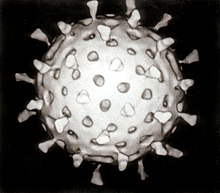Virus
| Viruses | |
|---|---|

| |
| Rotavirus | |
| Virus classification | |
| Group: | I–VII |
| Groups | |
|
I: dsDNA viruses | |
A virus is a smaw infectious agent that replicates anly inside the livin cells o ither organisms. Viruses can infect aw teeps o life forms, frae ainimals an plants tae microorganisms, includin bacteria an archaea.[1]
Syne Dmitri Ivanovsky's 1892 airticle descrivin a non-bacterial pathogen infectin tabaccae plants, an the diskivery o the tabaccae mosaic virus bi Martinus Beijerinck in 1898,[2] aboot 5,000 virus speshies hae been descrived in detail,[3] awtho thare are millions o teeps.[4] Viruses are foond in awmaist ivery ecoseestem on Yird an are the maist numerous teep o biological entity.[5][6] The study o viruses is kent as virology, a sub-speciality o microbiology.
While nae inside an infectit cell or in the process o infectin a cell, viruses exeest in the form o independent pairticles, or virions, conseesting o: (i) the genetic material, lang molecules o DNA or RNA that encode the structur o the proteins bi that the virus acts; (ii) a protein coat, the capsid, that surroonds an pertects the genetic material; an in some cases (iii) an ootside envelope o lipids. The shapes o thir virus pairticles range frae simple helical an icosahedral forms for some speshies tae mair complex structurs for ithers. Maist virus speshies hae virions ower smaw tae be seen wi an optical microscope, aboot ane hundert the size o maist bacteria.
The oreegins o viruses in the evolutionary history o life are unclear: some mey have evolved frae plasmids—pieces o DNA that can muive atween cells—while ithers mey hae evolved frae bacteria. In evolution, viruses are an important means o horizontal gene transfer, that increases genetic diversity in a wey analogous tae sexual reproduction.[7] Viruses are conseedert bi some tae be a life form, acause they cairy genetic material, reproduce, an evolve throu naitural selection, but lack key chairactereestics (sic as cell structur) that are generally conseedert necessar tae coont as life. Acause thay possess some but nae aw sic qualities, viruses hae been descrived as "organisms at the edge o life",[8] an as replicators.[9]
Viruses spreid in mony weys. Ane transmeession pathwey is throu disease-beirin organisms kent as vectors: for ensaumple, viruses are eften transmittit frae plant tae plant bi insects that feed on plant sap, sic as aphids; an viruses in ainimals can be cairied bi bluid-suckin insects. Influenza viruses are spreid bi cochin an neesin. Norovirus an rotavirus, common causes o viral gastroenteritis, are transmittit bi the faecal–oral route, passed bi contact an enterin the bouk in fuid or watter. HIV is ane o several viruses transmittit throu sexual contact an bi exposur tae infected bluid. The variety o host cells that a virus can infect is cried its "host range". This can be narrae, meanin a virus is capable o infectin few speshies, or braid, meanin it is capable o infectin mony.[10]
Viral infections in ainimals provoke an immune response that uisually eliminates the infectin virus. Immune responses can an aw be produced bi vaccines, that confer an artifeecially acquired immunity tae the speceefic viral infection. Some viruses, includin thae that cause AIDS an viral hepatitis, evade thir immune responses an result in chronic infections. Several antiviral drugs hae been developit.
References[eedit | eedit soorce]
- ↑ Koonin EV, Senkevich TG, Dolja VV. The ancient Virus World and evolution of cells. Biology Direct. 2006;1:29. doi:10.1186/1745-6150-1-29. PMID 16984643.
- ↑ Dimmock p. 4
- ↑ Dimmock p. 49
- ↑ Breitbart M. Here a virus, there a virus, everywhere the same virus?. Trends in Microbiology. 2005;13(6):278–84. doi:10.1016/j.tim.2005.04.003. PMID 15936660.
- ↑ Lawrence CM, Menon S, Eilers BJ, et al.. Structural and functional studies of archaeal viruses. The Journal of Biological Chemistry. 2009;284(19):12599–603. doi:10.1074/jbc.R800078200. PMID 19158076.
- ↑ Edwards RA, Rohwer F. Viral metagenomics. Nature Reviews Microbiology. 2005;3(6):504–10. doi:10.1038/nrmicro1163. PMID 15886693.
- ↑ Canchaya C, Fournous G, Chibani-Chennoufi S, Dillmann ML, Brüssow H. Phage as agents of lateral gene transfer. Current Opinion in Microbiology. 2003;6(4):417–24. doi:10.1016/S1369-5274(03)00086-9. PMID 12941415.
- ↑ Rybicki, EP. The classification of organisms at the edge of life, or problems with virus systematics. South African Journal of Science. 1990;86:182–86.
- ↑ Are viruses alive? The replicator paradigm sheds decisive light on an old but misguided question. Studies in History and Philosophy of Biological and Biomedical Sciences. 7 March 2016;59:125–34. doi:10.1016/j.shpsc.2016.02.016. PMID 26965225.
- ↑ Shors pp. 49–50
Bibliografie[eedit | eedit soorce]
- Dimmock, N.J; Easton, Andrew J; Leppard, Keith (2007) Introduction to Modern Virology saxt edeetion, Blackwell Publishing, ISBN 1-4051-3645-6.
- Shors, Teri (2008). Understanding Viruses. Jones and Bartlett Publishers. ISBN 0-7637-2932-9.
